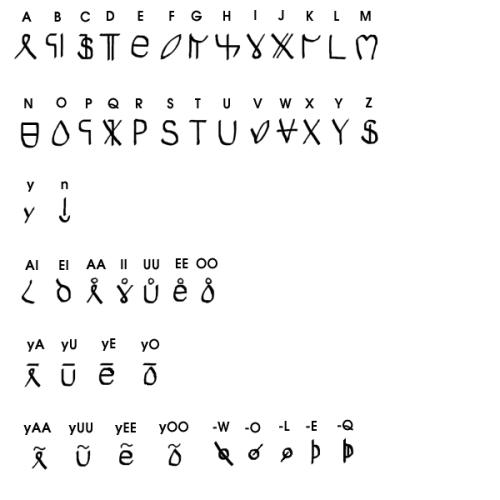
Noxilo language
Encyclopedia
Noxilo is an international auxiliary language, created by Mizuta Sentaro (水田 扇太郎 mizuta sentarō). In 1997 he published a book outlining the language, and presented it on his website. He claims it was created to address the alleged problems of several constructed languages, including; being based mostly on European languages, racism, and sexism.
A good illustration of the many origins of the words lie in the numbers. Below is a chart that displays a number, its pronunciation, and origin.
in that voiced consonants are derived from their unvoiced homologues (by adding a stroke), and there is a special letter for a syllable-final nasal.

A consonant on its own is pronounced with a following u, and a following u is pronounced long. This applied to those consonants written as capitals; minuscule y and n are single consonants. (n assimilates to a following consonant as [m n ŋ].):
When another vowel follows, the [u] is suppressed:
An unwritten [u] may be elided after a written vowel, unless there is an apostrophe to retain it:
Stress is on the first vowel, on any vowel before a double consonant, on any long vowel, and in longer words, on the third vowel (counting after any u has been dropped). This means that adjacent syllables may be stressed, something which does not occur in English.
Source of Words
The words of Noxilo are based on words from many languages: English, Arabic, Chinese, French, Japanese, Korean etc. Mizuta Sentaro, creator of the language, asserts that this makes it more equal for worldwide speakers of many languages, who wish to learn Noxilo. However, speakers may use as many words from their native language as they wish, making Noxilo potentially unintelligible to anyone who does not speak their language.A good illustration of the many origins of the words lie in the numbers. Below is a chart that displays a number, its pronunciation, and origin.
| Number | Spelling | Pronunciation | Origin |
| 0 | XUNyA | [ˈʃuːnja] | Sanskrit |
| 1 | II | [ˈiː] | Chinese |
| 2 | NI | [ˈni] | Japanese |
| 3 | SAM | [ˈsamu] or [ˈsam] | Korean |
| 4 | SII | [ˈsiː] | Thai |
| 5 | LIMA | [ˈlima] | Malay |
| 6 | ZEKS | [ˈzekusu] or [ˈzeksu] | German |
| 7 | SABAA | [ˈsaˈbaː] | Arabian |
| 8 | WIT | [ˈwitu] or [ˈwit] | French |
| 9 | KOO | [ˈkoː] | Burmese |
| 10 | TIO | [ˈtio] | Swedish |
| 100 | STO | [ˈsuto] | Russian |
| 1,000 | MILA | [ˈmila] | Italian |
| 10,000 | MAn | [ˈmaɴ] | Chinese |
| 100,000,000 | OK | [ˈoku] or [ˈok] | Korean |
| 1,000,000,000,000 | QO | [ˈtʃo] | Korean |
| 10,000,000,000,000,000 | KyOn | [ˈkjoɴ] | Korean |
Noxilo script
There are two forms of the Noxilo script: one using Latin letters, and one derived from Latin letters. In the Latin form of the alphabet uppercase and lowercase letters are treated as separate letters: Uppercase letters are syllables unless a vowel follows; lowercase (there are only two) are simple consonants. The original script is similar to kanaKana
Kana are the syllabic Japanese scripts, as opposed to the logographic Chinese characters known in Japan as kanji and the Roman alphabet known as rōmaji...
in that voiced consonants are derived from their unvoiced homologues (by adding a stroke), and there is a special letter for a syllable-final nasal.

Grammar
Sentences in Noxilo can use SOV and SVO. This was done so that speakers of most languages could use a word order that was familiar to them or at least close to something they were familiar with.Pronunciation
Pronunciation is essentially that of Japanese. Vowels as in Spanish (doubled vowels are long), consonants, including J and Y, are pronounced as in English (doubled consonants are long), except that C is like ts, Q is ch, and X is sh.A consonant on its own is pronounced with a following u, and a following u is pronounced long. This applied to those consonants written as capitals; minuscule y and n are single consonants. (n assimilates to a following consonant as [m n ŋ].):
- K [ku], Ky [kju], Kn [kun], Kyn [kjun], KU [kuː], KyU [kjuː], KUn [kuːn], KyUn [kjuːn].
When another vowel follows, the [u] is suppressed:
- KA [ka], KyA [kja], KAn [kan], KAA [kaː], KyAA [kjaː], KAAn [kaːn]
An unwritten [u] may be elided after a written vowel, unless there is an apostrophe to retain it:
- KI [ki], KIA [kia], K'I [kui].
Stress is on the first vowel, on any vowel before a double consonant, on any long vowel, and in longer words, on the third vowel (counting after any u has been dropped). This means that adjacent syllables may be stressed, something which does not occur in English.
External links
- Noxilo Main-page (in English, French, or Japanese)

